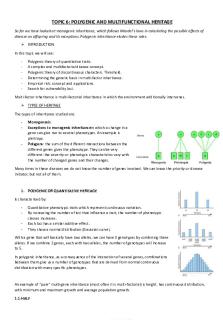Unit 6 - Lecture notes Unit 6 PDF

| Title | Unit 6 - Lecture notes Unit 6 |
|---|---|
| Author | Shelby VanConant |
| Course | Introduction to Biology |
| Institution | Western Governors University |
| Pages | 1 |
| File Size | 33.6 KB |
| File Type | |
| Total Downloads | 101 |
| Total Views | 162 |
Summary
Unit 6 Lesson objectives and notes...
Description
Unit 6: Classical Genetics Module 18: Heredity -
-
-
Distinguish between genotype and phenotype o Gene- a region of a chromosome that has a specific function o Phenotype- visible traits o Genotype- genetic information that produces the visible trait o Alleles- variations for genes Homozygous- cells that have the same allele Heterozygous- different alleles Identify how the law of segregation relates to allele dispersion during gamete production o Law of segregation: during meiosis I, the chromosome pair separates, resulting in haploid gametes. Each gamete will only have one allele Analyze the results of monohybrid crosses Interpret the results of dihybrid crosses Describe how the law of independent assortment increases gamete variety o Alleles combine with each other independent of each other
Module 19: Non-Mendelian Inheritance -
-
Identify alternative patterns of inheritance, such as incomplete dominance, codominance, and polygenic inheritance o Incomplete dominance- the heterozygous genotype exhibits an intermediate phenotype Ex. Red and white flower make a pink flower o Codominance- two alleles that are both dominant Ex. A and B blood group alleles, create an AB blood type o Polygenic Inheritance- some traits are determined by multiple genes Skin color Recognize that traits can be influenced by genes and the environment o Multifactorial Nature vs. nuture o serotonin
Module 20: Human Inheritance -
-
Identify autosomal and sex-linked patterns of inheritance o Some human traits follow Mendelian patterns, which means they are controlled by a single gene Human genetic disorders following a mendelian pattern are not very common Disorders that do follow a mendelian pattern tend to be recessive o Autosomal- chromosomes that are not sex determining o Sex-Linked Disorder- responsible gene is present on the sex chromosome Typically x chromosome Identify how changes in chromosome number leads to disorders o Karyotypes can be used to identify chromosomal abnormalities in cells or in developing fetuses o Aneuploidy is the condition of having too many or too few chromosomes, which results from errors in meiosis o If chromosomes do not separate properly during anaphase, the resulting cells can have extra or missing chromosomes (nondisjunction)...
Similar Free PDFs

Unit 6 - Lecture notes Unit 6
- 1 Pages

Unit 6 - Lecture notes 6
- 7 Pages

Unit 6 - Lecture notes 6
- 5 Pages

Unit 1 - Lecture notes 6
- 59 Pages

Unit 06 - Unit 6 notes
- 3 Pages

Unit 6 Notes
- 3 Pages

Unit 6 - notes
- 58 Pages

Worksheet 6-Unit 6
- 1 Pages

Unit 6 lab - Unit 6 lab
- 1 Pages

FULL UNIT 1 - Lecture notes 6
- 28 Pages

Unit 6 - Unit study guide
- 4 Pages

Self-Test 6 - Unit 6
- 4 Pages

Unit 6 - Written Assignment
- 4 Pages
Popular Institutions
- Tinajero National High School - Annex
- Politeknik Caltex Riau
- Yokohama City University
- SGT University
- University of Al-Qadisiyah
- Divine Word College of Vigan
- Techniek College Rotterdam
- Universidade de Santiago
- Universiti Teknologi MARA Cawangan Johor Kampus Pasir Gudang
- Poltekkes Kemenkes Yogyakarta
- Baguio City National High School
- Colegio san marcos
- preparatoria uno
- Centro de Bachillerato Tecnológico Industrial y de Servicios No. 107
- Dalian Maritime University
- Quang Trung Secondary School
- Colegio Tecnológico en Informática
- Corporación Regional de Educación Superior
- Grupo CEDVA
- Dar Al Uloom University
- Centro de Estudios Preuniversitarios de la Universidad Nacional de Ingeniería
- 上智大学
- Aakash International School, Nuna Majara
- San Felipe Neri Catholic School
- Kang Chiao International School - New Taipei City
- Misamis Occidental National High School
- Institución Educativa Escuela Normal Juan Ladrilleros
- Kolehiyo ng Pantukan
- Batanes State College
- Instituto Continental
- Sekolah Menengah Kejuruan Kesehatan Kaltara (Tarakan)
- Colegio de La Inmaculada Concepcion - Cebu


